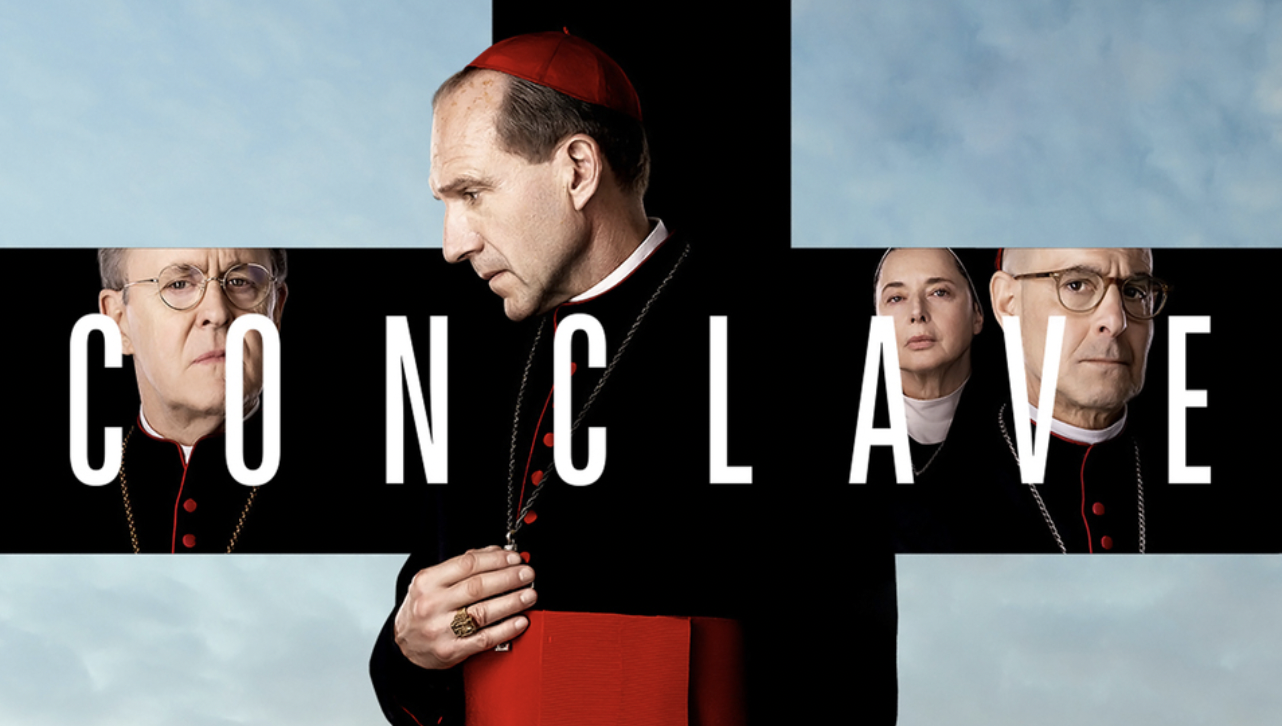Released in the US in October of this year and directed by Edward Berger (All Quiet on the Western Front), Conclave is, as the name suggests, a portrayal of the Church’s process of electing a new pope. Based on Robert Harris's 2016 novel of the same name, the film begins with the current Pope’s apparent sudden death, which seems to have taken many by surprise and is treated with a fair amount of suspicion. This all feels slightly ridiculous, as the fictional Pope looks like he is in his late 80s and could as easily have died from natural causes as from anyone wishing him ill.
Ralph Fiennes plays Cardinal Thomas Lawrence, Dean of the College of Cardinals, who presides over the conclave. Stanley Tucci portrays Cardinal Bellini, a liberal American cardinal, both of whom are concerned that the papacy should be handed to a liberal candidate, continuing the previous pontificate’s approach. John Lithgow is Cardinal Tremblay, a mainstream conservative, modelled as a Theodore McCarrick-type figure. Cardinal Joshua Adeyemi, played by Lucian Msamati, is a Nigerian cardinal with socially conservative views, and Cardinal Goffredo Tedesco, portrayed by Sergio Castellitto, is an Italian cardinal known for his traditionalist positions.
Just before the conclave begins, Cardinal Vincent Benitez, played by Carlos Diehz, arrives. He introduces himself as a cardinal and the Archbishop of Kabul, a role he was appointed to <em>in pectore</em> (secretly) by the late Pope, and is accepted into the conclave by Cardinal Lawrence. Sister Agnes, played by Isabella Rossellini, serves as the head caterer and housekeeper for the cardinals during the conclave and plays an important role by feeding Cardinal Lawrence vital information to help him navigate the proceedings.
Through a series of events, various candidates become “un-papabile”. Cardinal Adeyemi is revealed to have fathered a child 30 years earlier with one of the nuns catering at the conclave. Cardinal Bellini’s path to the papacy is blocked by internal politics and complex dynamics, leaving Cardinal Tremblay as the least objectionable option among the liberals. However, Cardinal Tremblay’s unsuitability is revealed after a report on his activities is printed and delivered to every cardinal by Sister Agnes. His McCarrick-like activities primarily involve simony—the buying or selling of ecclesiastical privileges, especially attempts to manipulate the election process.
This leaves the conservative Italian, Cardinal Tedesco, and a reluctant Cardinal Lawrence as the two most likely candidates. After a terrorist attack just outside the conclave interrupts events, Cardinal Tedesco delivers an impassioned speech against relativism and the "Islamification" of Europe, a kind of "Make the Vatican Great Again" moment. Though constant undertones have been given to Cardinal Benitez, it is now that he makes his first significant entrance. He responds to Tedesco in English stating his experience of working in war-torn lands and then switches to Spanish for a list of platitudes culminating with “the Church is not Tradition, the Church is not the Past, the Church is what we do next”.
In a somewhat rushed scene, this speech secures Benitez the two-thirds majority needed to become pope. This leads to the film's surprising twist: Benitez is revealed to be intersex. The film ends with artistic shots of Lawrence listening as Benitez makes his debut on the balcony of St. Peter's.
The star-studded cast ensures excellent performances throughout the film. The set is beautifully designed by Suzie Davies, who also designed Saltburn, the Brideshead Revisited-inspired film released last year, which won multiple awards for its set. Liturgical enthusiasts will likely find fault with some sartorial elements of the production, but to the untrained eye, the costumes work well. Volker Bertelmann, who previously worked with director Edward Berger on All Quiet on the Western Front, uses strings to create a suspenseful atmosphere.
The film also stands out as a movie intended for adults that does not rely on violence, sex or drugs to hold viewers’ attention, meriting its PG rating, which is refreshing in itself.
The film’s reception in the Catholic world has been overwhelmingly negative. Bishop Barron advised Catholics to “run away from it as fast as you can”. The Catholic League for Religious and Civil Rights called it “more a piece of anti-Catholic propaganda than a work of art”.
It is true that the film displays Catholicism in its worst light—bureaucratic, power-hungry and divided. However, at least from a British perspective, this portrayal is commonplace to the point of being unremarkable.
The characters themselves are reliably bland and caricatured representations of different political and social positions within the Church. The traditionalists are portrayed as harsh and xenophobic, the liberals as bureaucratic and scheming, with little depth beyond the thematic functions they serve.
Some will criticise the ending for being “woke”, but I would disagree. There is nothing particularly "woke" about intersex people. They existed well before social media and are created in the image and likeness of God. Neither do they fall outside the gender binary. If Benitez is a man, he would be a valid pope. If he is, as the film implies, a woman, then none of his orders would be valid, and he would not be. It really is that simple. The writers haven’t found a hypothetical scenario with no answer.
In conclusion, if you want to watch a film about ambition and power with good acting and a beautiful set, Conclave is worth seeing. But if you're looking for a film about Catholicism and the papacy, take Bishop Barron’s advice and run from it.



